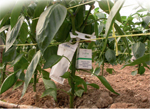Plant protection
Content
A good general principle for the gardener or grower is that they use as many different kinds of control as possible within a plant or crop cycle to bring about precise and efficient control for a pest or disease. And so a parasitic wasp may be encouraged or applied against an aphid attack, whilst also considering a cultural control such as the removal of alternate host weeds or a carefully considered pesticide if this is needed. A second principle highlights a distinction between pests and diseases. For pests, biological control is a major form of control in the natural environmental habitat (and to a similar extent in the garden/commercial holding when predators and parasites are encouraged). For diseases, however, in the natural environment, plant resistance (rather than biological control) is the important control method. In gardens and horticultural units, plants which have not been highly bred often exhibit a high level of resistance similar to their wild relatives. But intensively bred cultivars of annual flowers, annual vegetables and fruits may largely lack this important form of control. A third principle suggests that a programme of control against a pest or disease should consider non-pesticide controls first before relying on the alternative route. It has to be admitted that few people would disagree with the principle, but many growers will be able to cite instances when this idealistic attitude has left them with serious pest or disease problems on their hands (such as slugs in wet summers). In the ‘supervised control’ section of this chapter, there is a brief discussion of ‘economic damage’. At relevant points in this chapter, distinction is drawn between those measures available to the amateur gardener and those used by the professional grower. |





